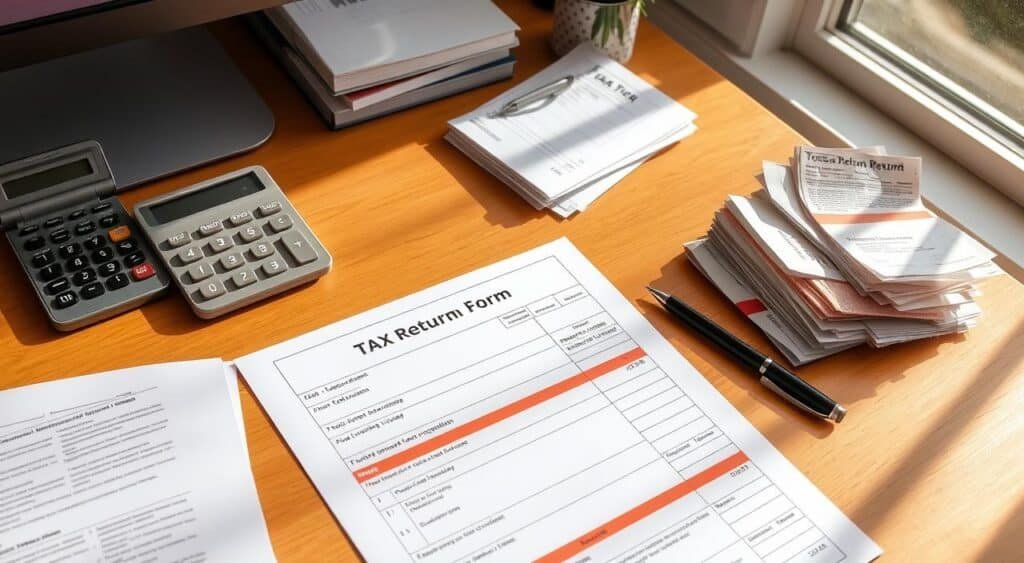Taxation returns are key to managing your money well. Knowing how to handle them can help you get more money back and pay less in taxes. This guide will walk you through five steps to understand your tax return. You’ll learn about income tax, deductions, credits, and more.
By following these steps, you’ll be able to file your taxes well. This means you’ll get the biggest refund possible.
Key Takeaways
- Understand the importance of accurate income tax withholding and adjusting Form W-4 to optimize your refund.
- Explore common tax deductions, including the standard deduction and itemized deductions, to reduce your taxable income.
- Leverage tax credits to directly reduce the amount of tax you owe, such as the Child Tax Credit and Retirement Savings Contributions Credit.
- Contribute to tax-advantaged savings plans like Roth IRAs and health/education savings accounts to lower your taxable income.
- Stay informed about changes in tax laws and deadlines to ensure you file your tax return accurately and on time.
Income Tax Withholding
Getting to know income tax withholding is key to handling your taxes. When you start a new job, you fill out Form W-4. This form sets how much tax is taken out of your paycheck. The IRS suggests checking your W-4 every year or when your life changes.
Form W-4 and Withholding Adjustments
If you have other jobs or deductions, you can change how much tax is taken out. You can update your Form W-4 with your employer or pay extra taxes to the IRS. This helps you avoid owing too much or getting a big refund.
Evaluating Additional Income Sources
Taxes are paid as you earn money, not just at the end of the year. Employers take out taxes from your paycheck and send it to the IRS. If you don’t have taxes taken out, like self-employed people, you might need to make estimated tax payments.
| Key Considerations | Details |
|---|---|
| Withholding Obligations | Withholding tax applies to both U.S. residents and nonresident aliens earning income from American sources. Employers are required to withhold federal income tax, Social Security tax, and Medicare tax from employee paychecks. |
| Adjusting Withholding | Employees can use Form W-4 with their employer to adjust federal income tax withholding. Factors like life changes, wage income, and taxable income can impact the amount that should be withheld. |
| Estimated Tax Payments | Self-employed individuals or those with income not subject to withholding may need to make quarterly estimated tax payments to the IRS to avoid penalties or a large tax bill at the end of the year. |
Managing income tax withholding means making sure the right amount is taken out of your paycheck. By understanding the process and making the right changes, you can avoid surprises. This keeps your finances in good shape with the IRS.
Utilizing Tax Deductions

Tax deductions can help lower your taxable income and boost your refund. There are two main types: the standard deduction and itemized deductions.
Standard Deduction vs. Itemized Deductions
The standard deduction is a fixed amount you can subtract from your income. In 2022, it’s $12,200 for singles and $24,400 for married couples. It’s easy to choose, but itemizing might save more if your expenses are high.
Common Itemized Deductions
- Medical Expenses: You can deduct medical costs over 7.5% of your income.
- Mortgage Interest: Homeowners can deduct mortgage interest up to $750,000.
- Property Taxes: You can deduct property taxes, up to $10,000.
- State Taxes: Deduct state and local income or sales taxes, up to $10,000.
- Charitable Contributions: Donations to charities are usually tax-deductible.
- Business Expenses: Self-employed folks can deduct business expenses.
Checking your tax deduction options can increase your refund and lower your taxes. The Inflation Reduction Act of 2022 brought new credits and deductions. Stay informed about tax changes.
“Maximizing your tax deductions is a smart way to keep more of your hard-earned money in your pocket.”
Leveraging Tax Credits

Understanding tax credits is key when you’re filing your taxes. Unlike deductions, which lower your taxable income, credits directly cut your tax bill. They’re especially helpful for specific costs or government programs.
Some top tax credits include the Child Tax Credit, Child and Dependent Care Credit, Retirement Savings Contributions Credit, and the Premium Tax Credit from the Affordable Care Act. The Earned Income Tax Credit also offers a big boost to your refund.
Knowing which credits you qualify for and how to claim them is crucial. The rules for tax credits changed for tax years starting after December 31, 2022. So, it’s important to keep up with the latest rules.
| Tax Credit | Description | Potential Savings |
|---|---|---|
| Child Tax Credit | A credit of up to $2,000 per child under the age of 17. | Up to $2,000 per eligible child |
| Child and Dependent Care Credit | A credit for expenses incurred for the care of a child or dependent. | Up to $4,000 for one dependent, $8,000 for two or more |
| Retirement Savings Contributions Credit | A credit for eligible contributions to retirement accounts. | Up to $1,000 for single filers, $2,000 for joint filers |
| Premium Tax Credit | A credit that helps cover the cost of health insurance premiums. | Varies based on income and insurance plan costs |
| Earned Income Tax Credit | A refundable credit for low to moderate-income individuals and families. | Up to $6,164 for taxpayers with three or more qualifying children |
Using these tax credits can lower your tax bill and increase your refund. Make sure to check if you qualify and claim them correctly on your taxes.
taxation return

Savvy taxpayers know that delaying income and saving in certain plans can boost their refund. Qualified retirement accounts like 401(k)s and IRAs lower your taxable income now. You pay less tax when you withdraw in retirement, when your tax rate might be lower.
Roth IRAs take after-tax money now but offer tax-free withdrawals later. Health savings accounts (HSAs) and education plans like 529 plans also cut your taxable income. Using these tax-advantaged savings accounts can greatly increase your refund.
“Contributing to qualified retirement accounts and tax-advantaged savings plans can be a smart way to reduce your taxable income and increase your tax refund.”
Retirement Account Contributions
- 401(k) contributions lower your taxable income now.
- Traditional IRA contributions might be deductible, reducing your taxable income.
- Roth IRA contributions use after-tax dollars but offer tax-free withdrawals later.
Tax-Advantaged Savings Accounts
- Health Savings Accounts (HSAs) let you put in pre-tax dollars for medical costs.
- 529 Plans help save for education and might reduce your taxable income.
By smartly using these tax-advantaged savings, you can cut your taxable income and get a bigger refund. It’s good for your finances and future. complete notice e-file data letter of 2024.
Also Read: Finance Securities for Beginners: A Quick Guide
Conclusion
Understanding your tax return can be tough, but knowing the right strategies helps. You can get the most from your refund and lower your taxes. Follow the 5-step guide in this article to file your taxes well.
Start by managing your income tax withholding. Use tax deductions and credits to your advantage. Also, take advantage of tax-advantaged savings plans. This way, you can get the biggest refund possible.
Stay organized and file early to avoid stress. If you need help, don’t hesitate to ask a professional. The IRS and Joint Committee staff review tax returns to improve service. Knowing this process helps you save on taxes.
It doesn’t matter if you’re an individual or a business owner. The key is to stay informed and manage your taxes well. This way, you can save on taxes and have a smooth filing experience.
FAQs
Source Links
- https://turbotax.intuit.com/tax-tips/tax-refund/do-the-math-understanding-your-tax-refund/L0SfgJGEq
- https://www.accounting.com/resources/how-to-do-taxes/
- https://www.irs.gov/individuals/employees/tax-withholding






